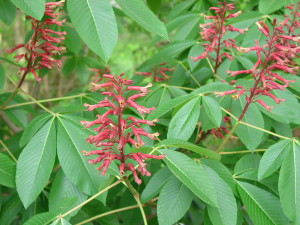Red buckeye (Aesculus pavia) is shrubby or low branching tree maturing to a 15 – 20 feet in height and spread. This southeastern U. S. native is becoming more recognizable as a good choice as a landscape tree for a small urban garden. Plant the tree in either full to partial sunlight and in average well-drained soil.
A tree may develop flowers when it is young in late April and May. Numerous 5 to 9 inches long floral heads sit at branch tips like decorative candles. Bloom count is highest in full day sun. Flowers open slightly before leaf emergence. Flower color on individual trees varies from dark pink to scarlet red. A yellow flowering form is known to exist. Hummingbirds arrive in time to pollinate the individual tubular blossoms.
Lovely palmate compound dark green leaves clothe the branches in spring thru early summer. In late September the broad seed pods split open exposing polished dark buckeye seeds; they drop from the tree, and are quickly grabbed up by squirrels and other garden critters. Don’t be surprised to find a young seedling or two germinating somewhere in the landscape in the years ahead.
Several disease and insect problems riddle the foliage; dry and hot summer weather will often scorch leaf edges unless irrigated weekly. Leaves succumb to the disease and weather onslaught resulting in premature leaf loss beginning in mid-August. Count on no autumn foliage color as branches are typically bare. Spraying pesticides to prevent diseases and insects is unnecessary. New flowers and foliage emerge unharmed the following spring. Deer and rabbits do not trouble this tree.
Pruning, if needed, is performed in mid-spring, right after flowering. Feed the tree lightly with 10-10-10 fertilizer (or equivalent) either before or following spring bloom.


 Posted in
Posted in 
